The sabal palm, or cabbage palm, is native to Florida and coastal regions of North and South Carolina and Georgia, and is the state tree of both South Carolina and Florida. The name "cabbage palm" comes from its edible immature leaves, or "heart," which has a cabbage-like flavor. Sabal palms have curved, costapalmate, fan-shaped leaves with blades 3–4 feet long and petioles 3–6 feet long. When free of nutrient deficiencies, this species has a full, round canopy atop a trunk 10–16 inches in diameter and up to 40 feet in height (Figure 1). Branched inflorescences produced during the late spring months usually extend beyond the leaves in the canopy and contain thousands of tiny, creamy-white, fragrant flowers that attract bees. The palm produces black fruits of about ¼ inch in diameter in late summer (Figure 2). Although the fruits contain little flesh, they are often consumed by raccoons and other animals that disperse the seeds. Sabal palms are considered cold hardy to about 15°F, or about USDA Zone 8b (for more about USDA Plant Hardiness Zones, visit http://planthardiness.ars.usda.gov/PHZMWeb/) (Meerow 2006). They are fairly tolerant of salt spray on their foliage, but intolerant of salt in their root zone.
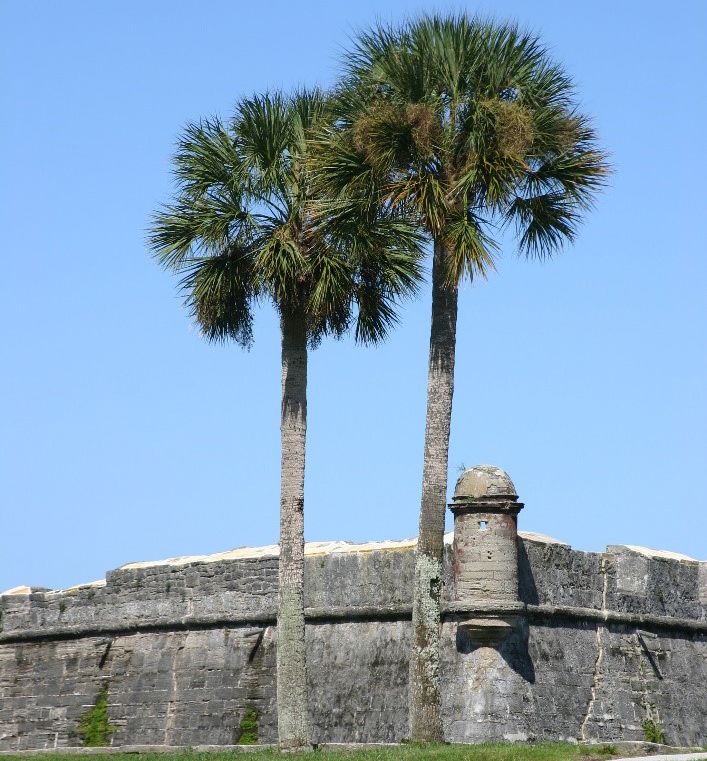
Credit: Stephen Brown, UF/IFAS
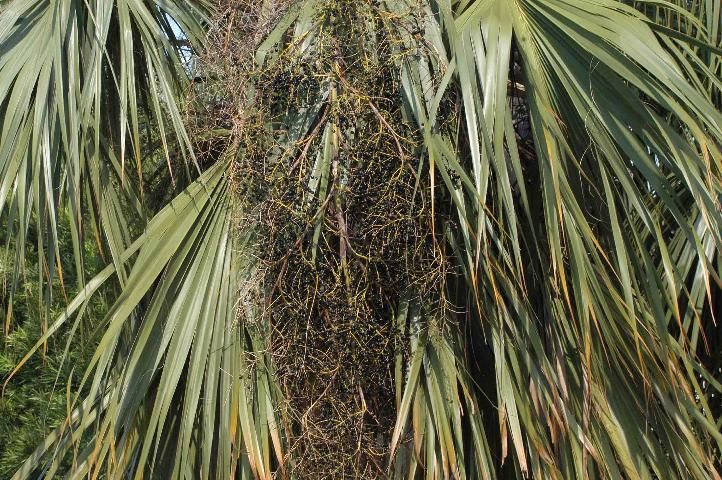
Credit: T. K. Broschat, UF/IFAS
Seed Germination
Sabal palm seeds are not difficult to germinate but should be planted when fresh for best germination. With uniform moisture and high temperatures (86°F–95°F), germination can occur in as few as 18 days, with 50% of final germination occurring within 33 days (Carpenter 1987; Sento 1970). Newly emerged seedlings look much like grass, but each succeeding leaf has an additional leaf segment that adds to their width. The slow-growing seedlings can take 15–30 years to develop a visible trunk under natural conditions, but in nurseries this can occur much faster (McPherson and Williams 1996). Initial trunk elongation can be quite rapid under favorable conditions (up to 6 inches per year), but this quickly slows to less than an inch per year as the palm matures (McPherson and Williams 1996).
Transplanting
Sabal palms are typically dug from pastures and other private property and transplanted as mature specimens into landscapes. Broschat and Donselman (1984) showed the root system of sabal palms is unusual in that cut roots do not branch and produce new growing tips, but rather die back to the trunk. The cut roots are replaced by massive numbers of new adventitious roots originating from the root initiation zone at the base of the trunk. Since young, trunkless sabal palms do not yet have functional root initiation zones to produce such replacement roots, transplanting these palms from the field at this stage is virtually impossible.
It can take 8 months or longer to produce a new root system in this species, and the palms must subsist solely on water stored in their trunks during that time. Palms with less than 10 feet of trunk appear to have insufficient water storage capacity to support themselves during this establishment period, resulting in high mortality rates. In an effort to reduce water loss from transplanted sabal palms during this stressful phase, Broschat (1991) demonstrated that removing all leaves from sabal palms at the time of digging increased survival rate to 95%, compared to 64% for those transplanted with a third of their leaves left on (Figure 3). Palms that were completely defoliated for transplant also had fewer dead leaves and larger canopies than those transplanted with a third of their leaves.
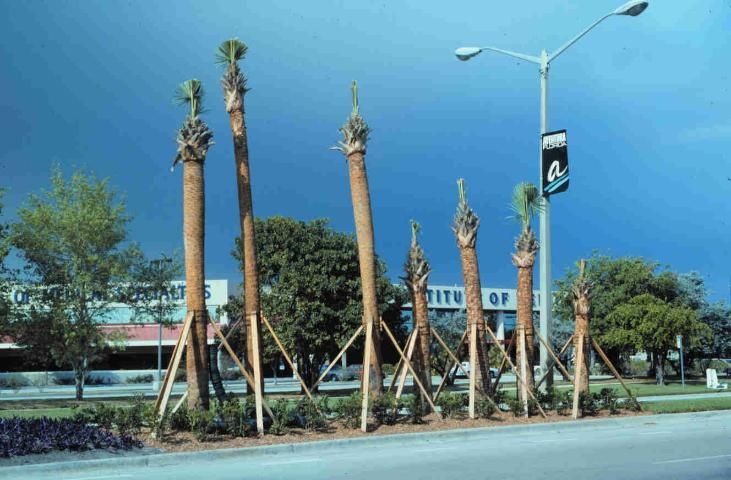
Credit: T. K. Broschat, UF/IFAS
Some nurserymen are transplanting sabal palms from the field into large containers, where more favorable environmental conditions can result in better survival rates. Palms with intact root systems and full canopies can then be transplanted with ease into the landscape. Careful root pruning 4–6 months prior to digging may also enhance transplant survival in palms with less than optimal trunk heights. Sabal palms should always be transplanted at the same depth as they were originally growing. Deeper planting can cause root suffocation and palm death. For more information about transplanting palms, see Transplanting Palms in the Landscape (https://edis.ifas.ufl.edu/ep001).
Nutrition and Fertilization
Sabal palms, like most palm species, should have a full 360° canopy of green leaves. Unfortunately, potassium (K) deficiency (https://edis.ifas.ufl.edu/ep269) causes premature leaf loss in palms and limits the number of leaves a palm can support. Thus, the number of leaves in a palm canopy (assuming the lower leaves have not been trimmed off) is a function of K deficiency severity.
In addition to a reduction in canopy leaf number, K deficiency causes visual symptoms on the oldest leaves. Mild K deficiency appears as translucent yellow-orange spotting on the oldest leaves, followed by extensive leaflet tip necrosis and foliar discoloration (Figure 4). Because K-deficient leaves are unsightly, people often trim them off, but these leaves serve a purpose for the palms and should not be removed until they are completely dead. Potassium is a mobile element within palms, and under deficiency conditions, the palms extract K from their oldest leaves and translocate it to the newly developing leaves. This allows growth to continue without interruption in the absence of sufficient K in the soil. Removing these K-deficient leaves removes a supplemental source of K for the palm. When sabal palm leaves are completely dead, they may be cut several inches from the trunk, leaving an attractive pattern of persistent split leaf bases. If left untrimmed, the brittle dead leaves typically snap off in high winds at varying distances from the trunk. In some specimens, these leaf bases persist on the trunk for many decades, while in others they fall off naturally after a couple of years (Figure 5). Leaf base persistence may be a genetic trait, but this has yet to be studied.
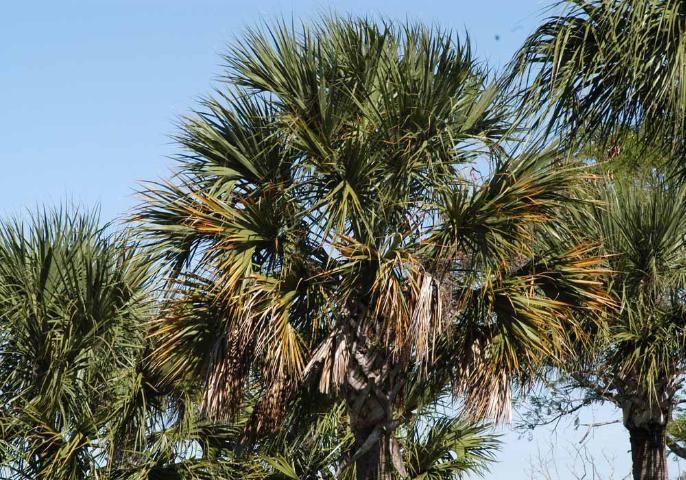
Credit: T. K. Broschat, UF/IFAS
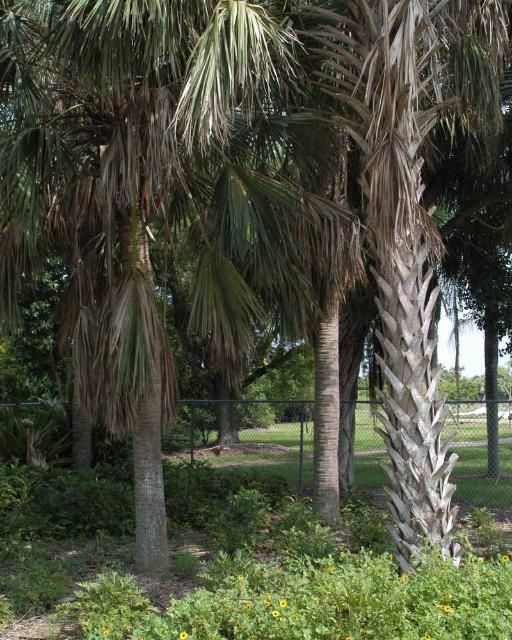
Credit: T. K. Broschat, UF/IFAS
The only other nutritional disorder encountered in sabal palms is magnesium (Mg) deficiency (https://edis.ifas.ufl.edu/ep266). This deficiency results in broad yellow bands around the perimeter of old leaves, with the central part of the leaf remaining green. Magnesium deficiency is usually induced by improper fertilization with fertilizers having high N:Mg or K:Mg ratios.
Sabal palms should be fertilized three times per year (four times in south Florida) with an 8-2-12-4Mg fertilizer in which 100% of the N, K, and Mg is in controlled-release form, the manganese (Mn) is in sulfate form, and the iron (Fe) is in sulfate or chelate form. If surrounding turfgrass or other ornamental plants are fertilized, they should be given the same fertilizer. See Fertilization of Field-Grown and Landscape Palms in Florida (https://edis.ifas.ufl.edu/ep261) for more details about palm fertilization.
Pests and Diseases
Stressed sabal palms are susceptible to palmetto weevil (Rhynchophorus cruentatus) invasion. Transplanted sabal palms are particularly attractive to this pest, which burrows into leaf bases and lays its eggs. The larvae then excavate much of the crown stem, killing the meristem in the process. See Palmetto Weevil (https://edis.ifas.ufl.edu/in139) for more information about this pest.
Sabal palms are relatively disease resistant, but they are susceptible to three lethal diseases. Ganoderma butt rot (https://edis.ifas.ufl.edu/pp100) is a soilborne fungus that invades the lower 3–4 feet of the trunk and causes trunk decay. Brown and white shelf-like conks may be present on the trunk (Figure 6). After about 80%–90% of the trunk cross-sectional area has rotted, wilt symptoms become apparent in the canopy, and the palm dies (Figure 7). There is no control for this disease, nor are there any known environmental factors that affect its occurrence.
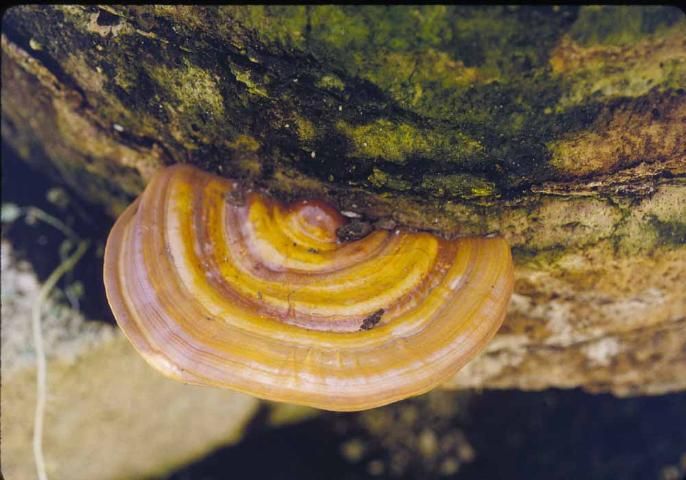
Credit: T. K. Broschat, UF/IFAS
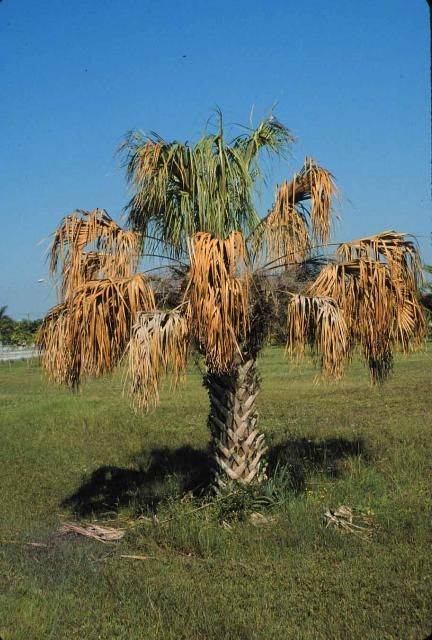
Credit: T. K. Broschat, UF/IFAS
Thielaviopsis trunk rot (https://edis.ifas.ufl.edu/pp143) also causes a lethal trunk rot in sabal palms, but this fungus requires a wound in the upper part of the trunk to gain entrance. Once established, this fungus causes a soft rot of the trunk, typically just below the canopy. When most of the trunk area has rotted, either the trunk collapses or the entire crown topples over. Wilt symptoms may provide some advanced warning of this trunk failure. There is no control for this disease, although preventing trunk wounds greatly reduces the chances of infection. This is not a common disease in sabal palms, and it is most likely to occur on recently transplanted sabal palms because some degree of trunk wounding typically occurs during handling.
A more recent disease of sabal palms is Texas phoenix palm decline (TPPD) (https://edis.ifas.ufl.edu/pp163), which is caused by a phytoplasma (a bacterium without a cell wall). This disease is similar to lethal yellowing (https://edis.ifas.ufl.edu/pp146), a disease that does not affect sabal palms. Both diseases are spread solely by phloem-feeding insects, such as planthoppers or leafhoppers. Symptoms of TPPD in sabal palms include the rapid wilt and death of the lower leaves, followed by spear leaf loss and meristem death (Figure 8). It is currently confined primarily to several counties in west central Florida, with Sarasota, Manatee, and Hillsborough Counties being the focal point. It can be prevented by injecting the trunk with the antibiotic oxytetracycline every 4 months.
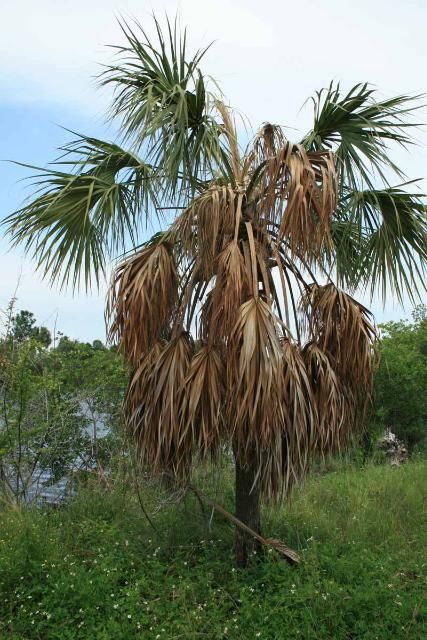
Credit: M. L. Elliott, UF/IFAS
A common problem in sabal palms is the sloughing of the "pseudobark" from the outside of the trunk. Once this occurs, further erosion of the trunk tissue can occur, often exposing the vascular bundles and occasionally destroying large sections of trunk (Figure 9). The cause of this problem has not been determined, and no pathogenic fungi have been isolated from affected trunk tissue. It has often been attributed to damage from irrigation sprinklers, but it also occurs on palms that have never been irrigated. It does not appear to have any noticeable effect on palm health or survival.
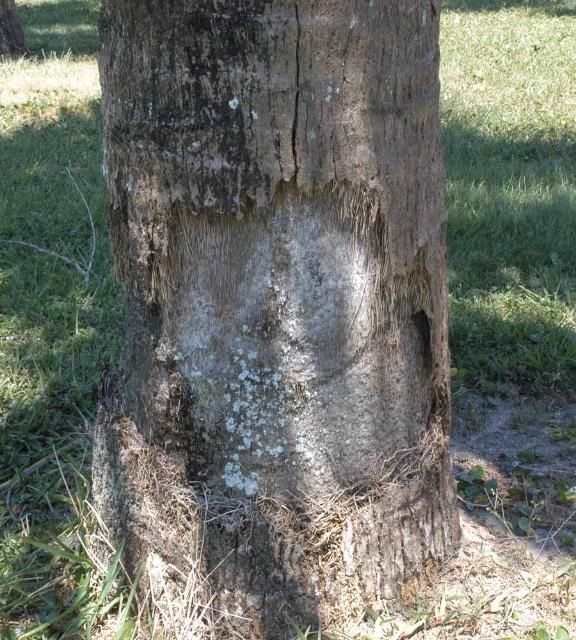
Credit: T. K. Broschat, UF/IFAS
Another "problem" that often causes concern is a translucent clearing of the leaf blade on either side of the costa (mid-rib of the leaf blade). This typically V-shaped area is visible only when the leaf is viewed from below (Figure 10). This condition is normal for this and several other Sabal species and is not indicative of any disease or nutritional deficiencies.
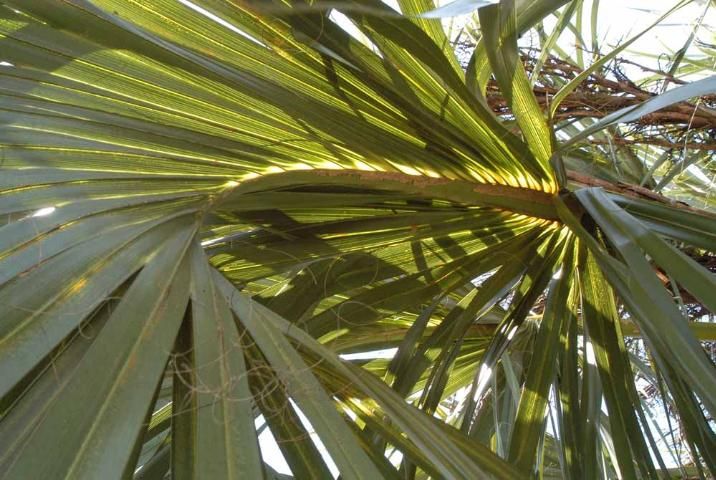
Credit: T. K. Broschat, UF/IFAS
Literature Cited
Broschat, T. K. 1991. "Effects of Leaf Removal on Survival of Transplanted Sabal Palms." J. Arboriculture 17: 32–33.
Broschat, T. K., and H. Donselman. 1984. "Root Regeneration in Transplanted Palms." Principes 28: 90–91.
Carpenter, W. J. 1987. "Temperature and Imbibitions Effects on Seed Germination of Sabal palmetto and Serenoa repens." HortScience 22: 660.
McPherson, K., and K. Williams. 1996. "Establishment Growth of Cabbage Palm, Sabal palmetto (Arecaceae)." Amer. J. Bot. 83: 1566–1570.
Meerow, A. W. 2006. Betrock's Landscape Palms. Hollywood, FL: Betrock Information Systems.
Sento, T. 1970. "Studies on the Germination of Seed of the Palms. II. On the Livistona chinensis (R. Brown), Phoenix roebelenii (O'Brien), and Sabal Species." J. Jap. Soc. Hort. Sci. 39: 261–268.